 |
 |
| 瀬戸の歴史散策コースの一部(2/2) Part of Seto Historical Walk Course(2/2) [Photos taken on June 23, 2001] |
鬼板
(鉄色に見える部分)(注1) |
法雲寺 −陶製梵鐘 (注2) Houunnji Temple - Bell of Buddhist temple made of ceramics (Note2) |
|
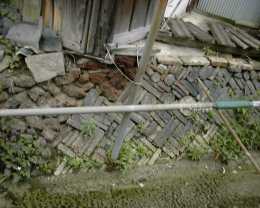 |
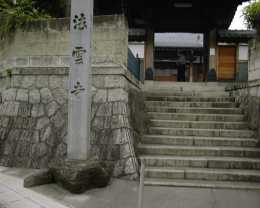 |
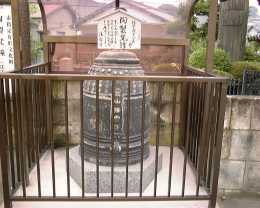 |
| 法雲寺 −加藤高明 (注3) Houunji Temple - Mr. Takaaki Kato (Note3) |
灯籠ー加藤民吉に謝して(注4) Lantern - Thanks ofr Tamikichi (Note4) |
深川神社境内の陶彦神社 Suehiko Shrine in the precinct of Fukagawa Shrine |
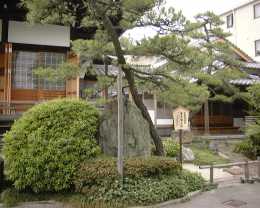 |
 |
 |
| 宮前橋の装飾ー染付焼きタイル1 (注5) Decoration on Miyamae bridge- Seo-Sometsuke tile 1 (See Note 5) |
宮前橋の装飾ー染付焼きタイル2 Decoration on Miyamae bridge- Seo-Sometsuke tile 2 (See Note 5) |
宮前橋の装飾ー染付焼きタイル3 Decoration on Miyamae bridge- Seo-Sometsuke tile 3 (See Note 5) |
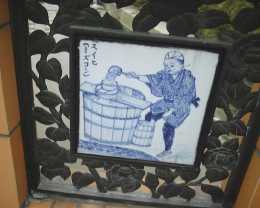 |
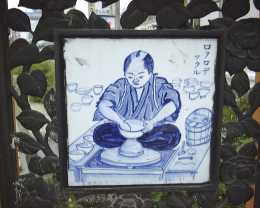 |
 |
| 宮前橋の装飾ー染付焼きタイル4 Decoration on Miyamae bridge- Seo-Sometsuke tile 4 (See Note 5) |
宮前橋の装飾ー染付焼きタイル5 Decoration on Miyamae bridge- Seo-Sometsuke tile 5 (See Note 5) |
宮前橋の装飾ー染付焼きタイル6 Decoration on Miyamae bridge- Seo-Sometsuke tile 6 (See Note 5) |
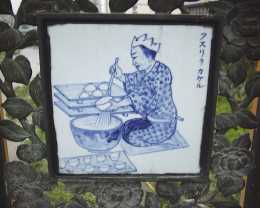 |
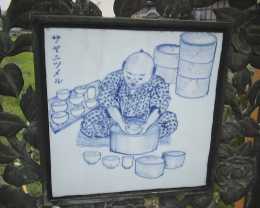 |
 |
| 宮前橋の装飾ー染付焼きタイル7 Decoration on Miyamae bridge- Seo-Sometsuke tile 7 (See Note 5) |
宮前橋の装飾ー狛犬 Decoration on Miyamae bridge- Guardian dog of pottery (See Note 5) |
尾張瀬戸駅(散策の終点) Owariseto station (end of walk) |
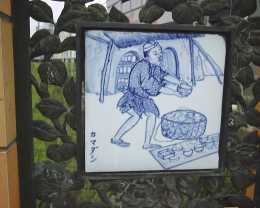 |
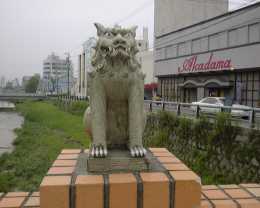 |
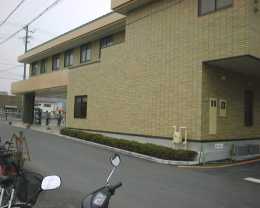 |
| 注1 | 鬼板 地中にある鉄分を含んだ土 |
| 注2 | 陶製梵鐘 第2次大戦中金属回収令で梵鐘を供出させられ、代用品として昭和17年(1942年)制作された。 現存するのは全国でこれだけと思われる。 |
| 注3 | 加藤高明 三菱財閥岩崎家の養子となったが、誇りか何故かわからないが、岩崎姓を取らなかった。 大正13.6.11−大正15.1.28の597日間24代目首相として在職。就任時年齢は 64歳。首相在職中病死した。 日本の初代首相は伊藤博文で2002年現在の小泉純一郎は87代目56人目の首相である。 |
| 注4 | 灯籠 1824年(文政7年)申9月吉日、加藤民吉に感謝して制作された。 |
| 注5 | 染付焼きタイル 江戸時代の陶工の様子(土掘りから陶磁器の制作迄の工程)が、欄干の下の表裏の腰板部に 貼り付けてある約50枚の染付焼きタイルに描かれている。 |
| 注6 | 1223年、永平寺の開山道元禅師に随行して入唐した加藤藤四郎は唐土(今の中国)に五年滞在し、 陶器の作り方を伝授 されて、安貞元年八月に帰国しました。 瀬戸市祖母懐で良質の陶土を発見し 釉薬付き陶器を焼き上げた。当時、日本では全て粗末な陶器が使われ、宋式の釉薬付き陶器は瀬戸 しか出来なかった。出来映えは宋式に比肩したとの事。詳細は陶器焼き窯考参照。 |
| Note 1 | Ogre plate Clay with iron content in the earth |
| Note 2 | Bell of Buddhist
temple made of ceramics Bell of Buddhist temple was delivered due to metal collecting law during the Second World War. So, the substifute mede of ceramics was manufactured in 1942. |
| Note 3 | Mr. Takaaki Kato He became a son in law of the Mitsubishi combine(zaibatsu), but did not take the family name, Iwasaki. I am not sure, but one of reasons I imagine will be pride. |
| Note 4 | Lantern The lantern was made as a token of people's gratitude for Mr. Tamikichi Kato in 1824. |
| Note 5 | Seto-Sometsuke
tile Working situation (stages from digging clay to producing ceramics) of potters in Edo era(about 300 years ago) is drawn on about 50 pcs of Seto-Sometsuke tiles sticked on wainscots of both inside and outside of the lower portion of handrails of bridge. |
| Note 6 | Mr. Toshiro Kato
visited a country, 'Tou' (China at present) following
priest, Dougen, the founder of Eiheiji Temple, and stayed there for 5 years to be given instruction on how to make pottery. He retruned to Japan, and found clay of good quality around Sobokai area in Seto village(Seto city at present) and fired(baked) potteries with glaze. Coarse(inferior) potteries were used in Japan at that time and potteries with glaze of Sou(China at present) style could be made only in Seto village. The workmanship were said to be comparable to the one of Sou style. Please see reference of Firing kiln of pottery for details.(only Japanese version). |